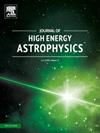Modelling the energy dependent X-ray variability of Mrk 335
IF 10.2
4区 物理与天体物理
Q1 ASTRONOMY & ASTROPHYSICS
引用次数: 0
Abstract
We present a technique which predicts the energy dependent fractional r.m.s. for linear correlated variations of a pair of spectral parameters and apply it to an XMM-Newton observation of Mrk 335. The broadband X-ray spectrum can be interpreted as a patchy absorber partially covering the primary emission, a warm and hot coronal emission or a relativistically blurred reflection along with the primary emission. The fractional r.m.s. has a non-monotonic behaviour with energy for segments of lengths 3 and 6 ksecs. For each spectral model, we consider every pair of spectral parameters and fit the predicted r.m.s. with the observed ones, to get the pair which provides the best fit. We find that a variation in at least two parameters is required for all spectral interpretations. For both time segments, variations in the covering fraction of the absorber and the primary power law index gives the best result for the partial covering model, while a variation in the normalization and spectral index of the warm component gives the best fit in the two corona interpretation. For the reflection model, the best fit parameters are different for the two time segment lengths, and the results suggests that more than two parameters are required to explain the data. This, combined with the extreme values of emissivity index and reflection fraction parameters obtained from the spectral analysis, indicates that the blurred reflection model might not be a suitable explanation for the Mrk 335 spectrum. We discuss the results as well as the potential of the technique to be applied to other data sets of different AGN.
求助全文
约1分钟内获得全文
求助全文
来源期刊

Journal of High Energy Astrophysics
Earth and Planetary Sciences-Space and Planetary Science
CiteScore
9.70
自引率
5.30%
发文量
38
审稿时长
65 days
期刊介绍:
The journal welcomes manuscripts on theoretical models, simulations, and observations of highly energetic astrophysical objects both in our Galaxy and beyond. Among those, black holes at all scales, neutron stars, pulsars and their nebula, binaries, novae and supernovae, their remnants, active galaxies, and clusters are just a few examples. The journal will consider research across the whole electromagnetic spectrum, as well as research using various messengers, such as gravitational waves or neutrinos. Effects of high-energy phenomena on cosmology and star-formation, results from dedicated surveys expanding the knowledge of extreme environments, and astrophysical implications of dark matter are also welcomed topics.
 求助内容:
求助内容: 应助结果提醒方式:
应助结果提醒方式:


